 |
|
|
| (Information by Peter Kessler, with additional information from The Establishment of the Balkan National States, 1804-1920, Charles Jelavich & Barbara Jelavich (A History of East Central Europe, University of Washington Press, 1986), from The Collapse of Yugoslavia, 1991-1999, Alastair Finlan (Osprey Publishing, 2004), from The Death of Yugoslavia, Laura Silber & Allan Little (Penguin Books, 1996), and from External Links: Yugoslavia: death of a federation (The Guardian), and Nation-Building in Croatia and the Treatment of Minorities: Rights and Wrongs, Antonija Petricusic (L'Europe en Formation, 2008/3-4, No 349-350, available via Cairn.info), and Encyclopaedia Britannica.) |
|
|
| 509 - 512 |
Members of the Heruli tribes who do not join the migration to Scandinavia initially seek refuge with the Gepids. Subsequently, some of them are allowed to resettle depopulated land in Singidunum (modern Belgrade) by theEastern Romans in 512. 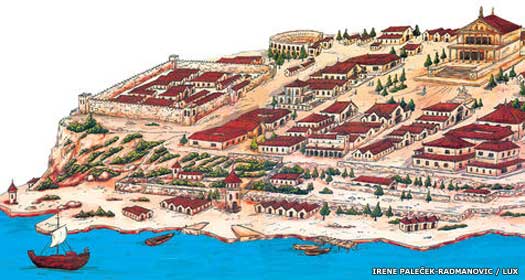 This artist's reconstruction shows the Roman city of Singidunum, the name originating in the preceding Celtic town, while the Serbs would settle it from the 520s, making it their on-off capital of Belgrade This artist's reconstruction shows the Roman city of Singidunum, the name originating in the preceding Celtic town, while the Serbs would settle it from the 520s, making it their on-off capital of Belgrade |
|
| 530s |
After one generation, the minor federate Heruli kingdom in Singidunum disappears from the historical record. These 'South Heruli' merge into surrounding populations or unite with the Langobards. |
|
| c.830 - 850 |
Vlastimir |
Knez of Serbia. |
| 839 - 842 |
Various Slavic tribes have recently been united into a single confederation under Vlastimir, the knez of the principality of Serbia. Eastern Roman Emperor Theophilus I has granted them independence (a tacit recognition of a fact which he is unable to change), in return for which he receives an acknowledgement of nominal overlordship for his lifetime. Worried about the creation of a new Slav state on his south-western border, Bulgarian Khan Presian invades. The Serbs, though, know their terrain. Vlastimir expels Presian with the latter making no territorial gains and suffering heavy losses. The death of Emperor Theophilus signals the end of the war. |
|
| 853 or 854 |
Seeking revenge for theBulgarian defeat of 842, an army is led into Serb lands by Vladimir 'Rasate', son of Boris I. Under the command of Mutimir and his two brothers, the Serbs again defeat the Bulgarians, capturing Vladimir and twelve boyars (nobles). Conflict is ended by a peace agreement. |
|
| ? - 917 |
Petar Gojniković |
Arrested and imprisoned byBulgaria. |
| 917 |
The promised war between Zoe's Constantinople and Emperor Simeon ofBulgaria now erupts. Leo Phokas 'the Elder' invades Bulgaria with naval support but his forces are slaughtered when they are caught unprepared. TheEastern Romans are utterly routed, with the Bulgarians chasing them to the outskirts of Constantinople. Another victory sees some of the last remaining cohesive Byzantine military units destroyed. Immediately afterwards, Simeon sends two commanders to trick Petar Gojniković, ruler of the Serbs, into handing himself over for having intended to mobilise in support of the Byzantines. He is duly seized and imprisoned. Simeon replaces him with a Serb exile by the name of Pavle Branović who had been living at the Bulgarian court. |
|
| 917 - ? |
Pavle Branović |
Ally of Bulgaria. |
| 922 - 924 |
Zaharije Pribisavljević |
Ally of Bulgaria. Defeated by Bulgaria and fled. |
| 924 |
Zaharije Pribisavljević is persuaded by theEastern Roman court to rebel against Simeon ofBulgaria. He already has the support of many Bulgarians who have tired of Simeon's unceasing campaigning against Constantinople. An initial force of loyal Bulgarians is routed, but a larger force deposes Zaharije, while much of the leading nobility is beheaded. Simeon takes direct control of Serbia. |
|
| 930 - 933 |
There are two family-led rebellions inBulgaria: one in 930 by a younger brother of Tsar Peter, named Ivan, and then a second, more serious attempt by the tsar's elder brother, Michael. Taking advantage of the tsar possibly being unsettled, the Serbs in 933 successfully rebel under the leadership of Prince Časlav Klonimirović, re-establishing the independence of the Serb state. |
|
| 933 - ? |
Časlav Klonimirović |
Threw offBulgarian rule. |
| 1010 |
As part of a major campaign to denude theEastern Romans of support in the Balkans, Tsar Samuel enters the Serb Duklja province. Its ruler, Jovan Vladimir, is forced to acquiesce toBulgarian overlordship. After Theodora Kosara, Samuel's own daughter - it is alleged by a medieval writer - had fallen in love with Vladimir she begs for his life. His largely peaceful rule of his people continues, and he plays no part in the conflict against the Byzantines. 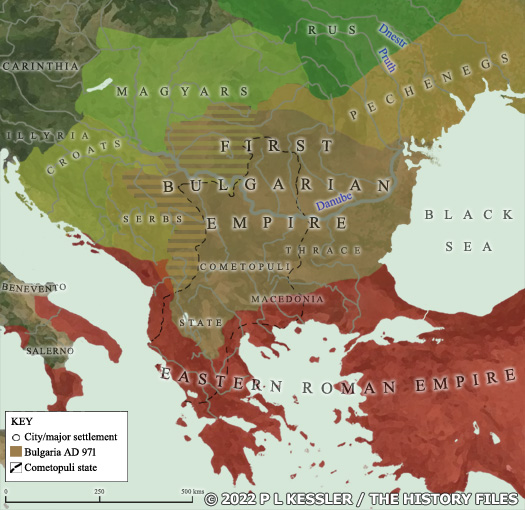 The (First) Bulgarian empire had controlled a great swathe of the Balkans during its existence, but its termination in 971 resulted in only its western territories remaining independent (within the dashed line), governed by the cometopuli (click or tap on map to view full sized) The (First) Bulgarian empire had controlled a great swathe of the Balkans during its existence, but its termination in 971 resulted in only its western territories remaining independent (within the dashed line), governed by the cometopuli (click or tap on map to view full sized) |
|
|
|
|
| Kingdom of Serbia AD 1217 - 1345 |
|
|
| 1151 - 1196 |
Stephan I Nemanja |
|
| 1163 - 1180 |
The Serbs and Bosnians fall to the Eastern Romans. |
|
| 1196 - 1228 |
Stephen II the First-Crowned |
First king of Serbia in 1217. |
| 1204 |
The capture of Constantinople is the Fourth Crusade's 'success', and Latin emperors are established in the city. The Byzantines withdraw to Nicæa in Anatolia, but rival claimants also established holdings in Trebizond and Epirus so that, at one point, there are four claimants to the Byzantine throne, as well as the Bulgar and Serb states. Close allies of Constantinople through intermarriage and trade, includingAlania and theRus, are badly affected by this disaster. |
|
| 1228 - 1234 |
Stephen III Radoslav |
|
| 1234 - 1243 |
Stephen IV Vladislav |
|
| 1243 - 1276 |
Stephen Urosh I |
|
| 1276 - 1282 |
Stephen Dragutin |
|
| 1282 - 1321 |
Stephen Urosh II Milutin |
|
| 1321 - 1331 |
Stephen Urosh III Dechanski |
|
| 1330 |
Michael Asen, using the name to link his reign to the precedingAsens, normally known as Michael Shishman, his family name, has pursued an aggressive policy of establishing Bulgaria as the leading power in the Balkans. Having agreed an alliance withEastern Roman Emperor Andronicus III, he organises a major attack against Serbia. Poor coordination with the Roman forces means that Michael faces a Serb army which is equal to his in numbers. The Serbs are quickly reinforced before battle commences near Velbazhd (now Kyustendil inBulgaria). |
|
| 1331 - 1345 |
Stephen Urosh IV Dušan |
Empire declared. |
| 1336 - 1337 |
Members of the nobility within the reduced kingdom ofAlbania see Angevin rulers as a form of protection against Serb interests, and in 1336-1337 Charles, duke of Durazzo, enjoys some success against Serb forces in central Albania. The Serbs, though, appear to be fully in control of Albania by 1346, two years before Charles is decapitated by his cousin, Phillip. |
|
|
|
|
| Empire of Serbia AD 1345 - 1459 |
|
|
| 1345 - 1355 |
Stefan Urosh IV Dušan |
First tsar of Serbia. |
| 1355 |
The death of Emperor Stefan Dušan allows members of theAlbanian nobility to establish independent or semi-independent dominions of their own. Unfortunately this is just as Ottoman forces are entering the local region. |
|
| 1355 - 1374 |
Stephen Urosh V the Weak |
|
| 1374 |
The dynasty collapses and with it royal authority. |
|
| 1371 - 1389 |
Lazar |
Prince of Serbia |
| 1387 |
The principality of Serbia and the kingdom of Bosnia manage to unite their forces to inflict a defeat upon the Ottomans at the Battle of Pločnik. The European victory emboldens other rulers, including Tsar John Shishman of Bulgaria who refuses to send troops to support his nominal overlords. Unfortunately he pays the price for that disobedience. |
|
| 1389 |
The Battle of Kosovo, 'Field of the Blackbirds', takes place where the Serbs andOttomans slaughtering each other to a poorly-recorded stalemate. Today the site lies within Kosovo. |
|
| 1389 - 1427 |
Stephen Lazarevich |
Despot. Ottoman vassal from 1396. |
| 1427 - 1456 |
George Brankovich |
|
| 1456 - 1458 |
Lazar Brankovich |
|
| 1459 - 1878 |
Serbia is annexed and ruled by Ottoman Turks. |
|
| 1804 - 1878 |
Two Serbs lead a long revolt which ultimately leads to Serbian independence. There is a bitter inter-rivalry between the two revolutionaries' families (Karageorgevich and Obrenovic), and this leads to much bloody in-fighting. |
|
|
|
|
| Principality of Serbia AD 1811 - 1882 |
|
|
| 1804 - 1813 |
Djordje Petrovic / Kara ('Black') George |
Lord. Led anti-Ottoman revolt. Confirmed as ruler in 1811. |
| 1815 - 1817 |
Milos Obrenovic |
Led anti-Ottoman revolt. |
| 1817 - 1839 |
Milos Obrenovic |
Prince. |
| 1828 - 1829 |
The Russo-Turkish War, triggered by the fighting in Greece and the Danubian principalities, ends in the Peace of Adrianople. The Ottoman sultan closes the Dardanelles to Russian vessels but the Russians lay siege to three major Ottoman cities in Bulgaria. In the end, despite an embarrassing defeat along the way, Russia wins the mouth of the Danube and much of the Black Sea's western coast under the terms of the peace, or Treaty of Adrianople. Serbia also achieves autonomy. |
|
| 1839 |
Milan I Obrenovic |
Prince. Son. |
| 1839 - 1842 |
Michael Obrenovic |
Prince. Second son of Milos. |
| 1842 - 1858 |
Alexander Karadjordjevic (Karageorgevich) |
Prince. Son of Djordje Petrovic. |
| 1858 - 1860 |
Milos Obrenovic |
Restored. |
| 1860 - 1868 |
Michael |
Restored. |
| 1868 - 1882 |
Milan II Obrenovic |
Prince. First cousin, once removed, of Michael. |
| 1875 - 1878 |
The Treaty of San Stephano makes most of the Balkans independent of Ottoman control, and the Congress of Berlin (1878) officially creates an independent Serbian state. |
|
| 1882 |
The independent state is elevated to a kingdom. |
|
|
|
|
| Kingdom of Serbia (Restored) AD 1882 - 1918 |
|
|
 |
|
|
| (Additional information from The First World War, John Keegan (Vintage Books, 2000).) |
|
|
| 1868 - 1882 |
Milan II Obrenovic |
Elevated to king. |
| 1882 - 1903 |
Alexander I |
Son. Murdered. |
| 1903 - 1918 |
Peter I Karadjordjevic |
Son of Alexander Karadjordjevic. |
| 1914 |
The heir to the throne of [Austria-Hungary](GermanyAustria.htm#Habsburg Emperors), Archduke Franz Ferdinand, is assassinated by Serb nationalists. The murder is used by Austria to declare war on Serbia, from which declaration the First World War results, with Germany becoming immediately involved as a close ally. |
|
| 1915 |
Bulgaria joins the war on the side of Germany and[Austria-Hungary](GermanyAustria.htm#Habsburg Emperors), agreeing to attack Serbia in exchange for territory.Britain andFrance land troops in neutral Greece in an attempt to support Serbia, but the help comes too late. Belgrade is taken on 9 October, with the king and the army heading intoMonte Negro rather than surrender. |
|
| 1918 |
On 6 October, a 'Southern-Slav' kingdom is declared by the Serb, Croat, and Slovene subjects of the [ Austro-Hungarian](GermanyAustria.htm#Habsburg Emperors) empire. This includes the Kosovo region (liberated in 1913), Bosnia, Herzegovina, Macedonia, and Monte Negro. Serbia is the dominant member of the new Yugoslavia and views much of the territory as being part of a traditional 'Greater Serbia'. |
|
|
|
|
| Kingdom of Yugoslavia (Serbs, Croats & Slovenes) AD 1918 - 1941 The kingdom of 'Southern Slavs' was founded as the kingdom of Serbs, Croats &Slovenes in 1918. Its second king, Alexander II, altered the name in 1929 to the kingdom of Yugoslavia (Kraljevina Jugoslavija). From the outset, in the wake of the First World War, the concept of a nation of the southern Slavs, the broad translation of 'Yugoslavia', was an alien one. It was foisted on the disparate and mutually suspicious peoples of the region by a European diplomatic establishment which was desperate to create order out of chaos. The war itself had been sparked by Balkan jealousies and passions, and the role played during it by Balkans states had done little to settle the ageless grievances within the turbulent region. The well-meaning but simplistic answer was to draw a line around the disputed territories on the north-eastern shores of the Adriatic, and call the area Yugoslavia. Within the new nation, essentially an expanded kingdom of Serbia, were Serbs, Croats, Slovenes, Montenegrins, Albanians, Hungarians, and Macedonians. Very few would ever call themselves Yugoslavians. |
|
|
 |
|
|
| (Additional information from The First World War, John Keegan (Vintage Books, 2000), and from External Link: Yugoslavia: death of a federation (The Guardian).) |
|
|
| 1918 - 1921 |
Peter I Karadjordjevic |
Territory expanded. |
| 1918 - 1921 |
Alexander II |
Regent. |
| 1921 - 1934 |
Alexander II |
Son of Peter I. m Marie, dau of King Ferdinand of [Rumania](EasternRumania.htm#Kingdom of Rumania). |
| 1928 - 1929 |
Albania slips out of Alexander's grasp with its own proclamation of a kingdom. The Serb-born king, Alexander, renames the kingdom. All citizens are required to declare themselves as Yugoslavs in the subsequent census. |
|
| 1934 |
The dictatorial, and anti-fascist, Alexander is assassinated in Marseille by a Croatian, at least partially in revenge for the Serb killing of the Croatian parliamentary leader in 1928, but probably also because of his resistance to fascism. |
|
| 1934 - 1941 |
Peter II |
Son. Went into exile in 1941. Maintained claim until 1945. |
| 1934 - 1941 |
Paul |
Regent. Grandson of Alexander Karadjordjevic. |
| 1941 - 1945 |
The Nazi German and Italian occupation of Yugoslavia brings the kingdom to an end.Croatia, which has always regarded itself (with legal justification) as autonomous, is granted a puppet king by its Italian pro-Nazi occupiers. However, this is extremely hard-line fascist in nature, and ethnic Serbs are soon the targets of a campaign of terror. The kingdom of Yugoslavia itself surrenders with barely a fight, and is occupied until a new, federal state ofYugoslavia can be established after the war. |
|
| 1943 - 1945 |
The Nazi Germans occupy Serbia alone after the Italian surrender. |
|
|
|
|
| Federal & Socialist Yugoslavia (Serbs, Croats & Slovenes) AD 1945 - 2006 Incorporating the Union of Serbia and Montenegro The kingdom of Yugoslavia was founded in 1918 as a kingdom of Serbs, Croats, and Slovenes. The name was created by its second king, Alexander II, from the 'Kingdom of Southern Slavs'. Its fragile stability in the post-First World War period had been subjected to many threats, primarily those involving fascists and communists, and royalists and republicans. Invasion by Nazi Germany in 1941 destroyed that stability and led to two simultaneous regional wars: one of resistance against the invaders, and a parallel one between royalists (the Chetniks) and communists. The latter won, under the leadership of Josip Broz Tito. With the help of generous military aid from the British and their allies whose primary goal was to see Germany and Italy defeated. Tito was able to crush his internal rivals and install his regime in Belgrade in the wake of the German retreat. He inherited a state which was quickly reorganised into a remarkably open and progressive federation of six nominally equal republics, while the two Serbian provinces of Kosovo and Vojvodina were given autonomous status in order to acknowledge specific interests of their ethnic majority populations of Albanians and Hungarians respectively. In 1946 Bosnia and Herzegovina became one of those constituent republics of the 'Federal People's Republic of Yugoslavia'. In 1963 a new constitution was drawn up which dictated a more loosely-coordinated union (the second of three such constitutional changes, the others being in 1953 and 1974). At the same time the 'Federal People's Republic' became the 'Socialist Federal Republic'. Fragmentation of the socialist state began in 1991 with the departure of Croatia, Istria, Macedonia, and Slovenia. Belgrade briefly attempted to strong-arm Slovenia back into the fold, being met with almost immediate failure. Its attempts with Croatia were much more damaging and long-running. In the meantime Bosnia and Herzegovina also departed (in 1992) and faced the same hostile treatment from Belgrade. Economic sanctions and a reorganisation in the Yugoslav parliament finally ended support for Serb rebellions in Bosnia and Croatia in 1995. Kosovo was effectively lost in 1999, and Yugoslavia was reorganised in 2003 into the 'Union of Serbia and Montenegro' which, as suggested, only included Montenegro. That too left, in 2006, signalling the final end of any concept of Yugoslavia. At one time a large number of Germans lived alongside Hungarians in the Vojvodina, the northern end of modern Serbia which begins almost immediately to the north of Belgrade and abuts Hungary at the Serbian border. The post-war communist government expelled virtually all German speakers in 1945. This group had descended from [Austrian](GermanyAustria.htm#Habsburg Archdukes) and German families which had been brought in by Austria's Empress Maria Theresa during the eighteenth century. King Peter II of Yugoslavia retained his title in exile until 1945-1946 and the creation of the federal state. Following that he maintained his claim on the former throne until his death in 1970, after which he was succeeded by his son, Alexander II. He and successive claimants to the throne are shown with a shaded background. From 2001 they were allowed back into Belgrade as late-Yugoslavian Serbia adjusted to its still-forming change of identity. |
|
|
 |
|
|
| (Information by Peter Kessler, with additional information from theJohn De Cleene Archive, from The Establishment of the Balkan National States, 1804-1920, Charles Jelavich & Barbara Jelavich (A History of East Central Europe, University of Washington Press, 1986), from The Collapse of Yugoslavia, 1991-1999, Alastair Finlan (Osprey Publishing, 2004), from The Death of Yugoslavia, Laura Silber & Allan Little (Penguin Books, 1996), and from External Links: Yugoslavia: death of a federation (The Guardian), and Nation-Building in Croatia and the Treatment of Minorities: Rights and Wrongs, Antonija Petricusic (L'Europe en Formation, 2008/3-4, No 349-350, available via Cairn.info), and Encyclopaedia Britannica, and Yugoslavia: 1918 - 2003, Tim Judah (available via the BBC, 2011).) |
|
|
| 1945 - 1980 |
Josip Broz Tito |
Communist dictator. Died 4 May 1980. |
| 1945 - 1970 |
Peter II |
Exiled former king of Yugoslavia. Retained claim. |
| 1945 - 1946 |
The communist forces under the half-Slovene half-Croat leader, Josip Broz Tito, take over the state after fighting off the Nazi Germans. Yugoslavia gains Istria from Italy but otherwise largely retains its pre-war borders. What it does not retain is its monarchy which, in the form of King Peter II, has been exiled. 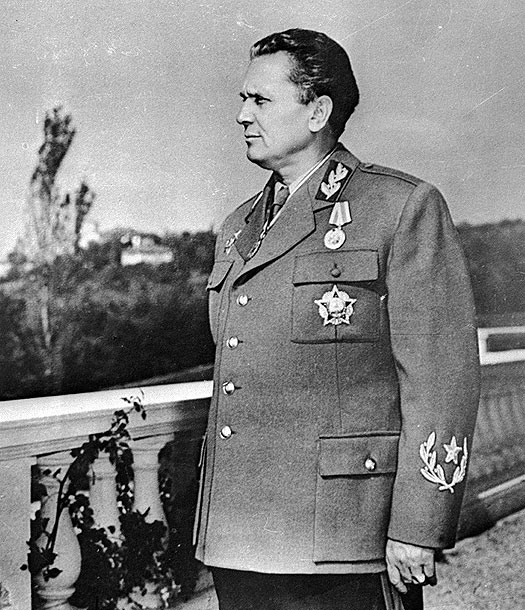 Josip Broz Tito, president and marshal of the federal republic of Yugoslavia in 1947, dressed to celebrate the second anniversary of the defeat of Nazi Germany Josip Broz Tito, president and marshal of the federal republic of Yugoslavia in 1947, dressed to celebrate the second anniversary of the defeat of Nazi Germany |
|
| The 'People's Republic of Bosnia and Herzegovina' becomes one of the constituent republics of the new 'Federal People's Republic of Yugoslavia', and life in Bosnia and Herzegovina undergoes all the social, economic, and political changes which are imposed across the whole of Yugoslavia by its new communist government. |
|
|
| 1947 |
Italy loses sections of its eastern territory to Yugoslavia under the terms of the Paris peace treaties. This includes Dalmatia, with that and most of Istria today being part of Croatia. |
|
| 1948 |
The communist leadership in Albania has always been plagued by factional division, and by now has split into two camps. A growing rift between Josip Tito and Joseph Stalin in this year gives Enver Hoxha a Soviet ally with whose support he can now act to preserve his own position, and he soon manages to eliminate his rivals. By June 1948, after several years of Yugoslavian tutelage, Albania enters the Soviet fold while Yugoslavia is expelled from it. 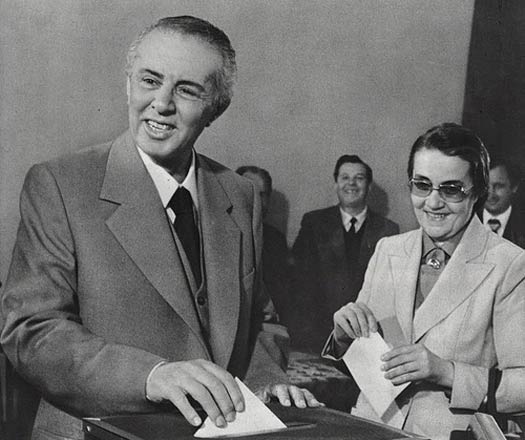 Enver Hoxha, here photographed alongside his wife, Nexhmije Hoxha, pursued a ruthless purge of intellectuals of the like which was often seen during the brutal pro-communist years of the post-Second World War period Enver Hoxha, here photographed alongside his wife, Nexhmije Hoxha, pursued a ruthless purge of intellectuals of the like which was often seen during the brutal pro-communist years of the post-Second World War period |
|
| 1954 |
Trieste has been occupied by British, US, and Yugoslav forces since the end of the Second World War. On 26 October 1954 its control is permanently divided between Italy and Yugoslavia. |
|
| 1963 |
The 'Federal People's Republic of Yugoslavia' becomes the 'Socialist Federal Republic', and Josip Tito becomes president for life, abandoning any pretence (if any remains) of being an accountable leader with any form of fixed term of office. |
|
| 1970 - 2006 |
Crown Prince Alexander II |
Son of Peter II. Born 1945 London. In Belgrade from 2001. |
| 1980 - 1981 |
The death of Tito, the president for life, brings changes to the top level of Yugoslavia's administration. Instead of nominating or suffering a successor as president (dictator in all but name), a collective presidency is established. This consists of representatives of the leadership of all of the republics within the socialist state, with one state holding the presidency for a year on a pre-agreed rotating basis. The real rulers of Yugoslavia until 1987 are the heads of the party. 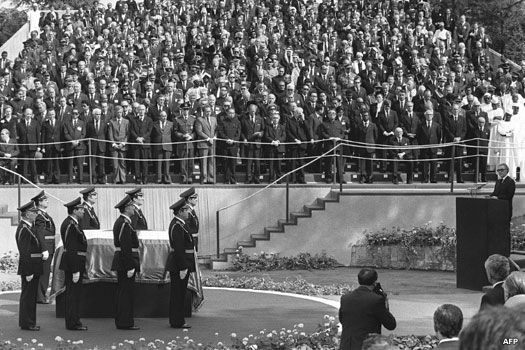 Tito was honoured with a state funeral following his death in 1980: viewed by many as the father and saviour of the Yugoslav state, his loss meant the beginning of great changes in the Balkans Tito was honoured with a state funeral following his death in 1980: viewed by many as the father and saviour of the Yugoslav state, his loss meant the beginning of great changes in the Balkans |
|
| 1980 |
Lazar Kolisevski |
Communist chairman of the collective presidency. |
| 1980 - 1981 |
Cvijetin Mijatović |
Communist chairman of the collective presidency. |
| 1981 |
Riots break out and are violently suppressed by the communist authorities after Kosovo Albanians openly demand that Kosovo be granted full republic status. It remains an autonomous region for now. |
|
| 1981 - 1982 |
Sergej Kraigher |
Communist chairman of the collective presidency. |
| 1982 - 1983 |
Petar Stambolić |
Communist chairman of the collective presidency. |
| 1983 - 1984 |
Mika Špiljak |
Communist chairman of the collective presidency. |
| 1984 - 1985 |
Veselin Đjuranović |
Communist chairman of the collective presidency. |
| 1985 - 1986 |
Radovan Vlajković |
Communist chairman of the collective presidency. |
| 1986 - 1987 |
Sinan Hasani |
Communist chairman of the collective presidency. |
| 1987 |
Although the position of chairman of the collective presidency continues until 1990, it is Slobodan Milošević who emerges as the true power in Yugoslavia. He is the chairman of the 'Central Committee of the League of Communists' (and therefore party leader) in Serbia. 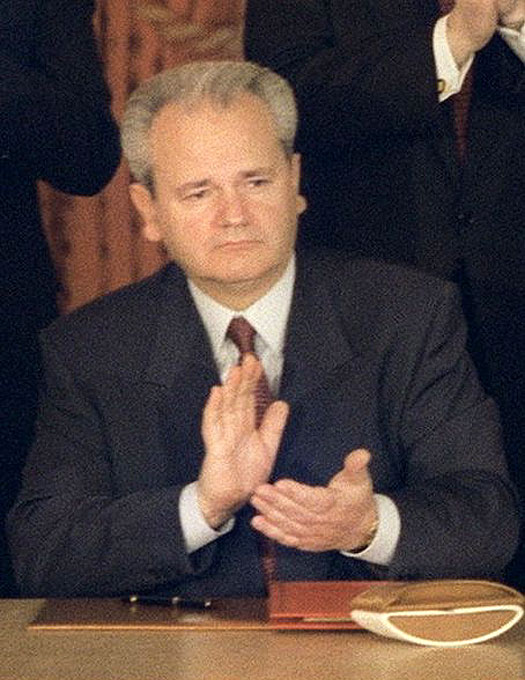 Slobodan Milošević was photographed here just after he had signed the Dayton Accords (or Dayton Agreement), the 1995 peace agreement which arranged the post-war political landscape in the Balkans Slobodan Milošević was photographed here just after he had signed the Dayton Accords (or Dayton Agreement), the 1995 peace agreement which arranged the post-war political landscape in the Balkans |
|
| 1987 - 2000 |
Slobodan Milošević |
President of Serbia & Yugoslavia. |
| 1988 |
In February 1988, Petar Stambolić formally resigns, having been outmanoeuvred by Milošević. This allows Milošević to take his place as Serbia's president. He subsequently initiates a programme of IMF-supported free-market reforms. In May 1988 he sets up the 'Milošević Commission' which comprises Belgrade's leading neo-liberal economists. |
|
| 1989 |
The fiction of a united Yugoslavia is finally exposed, not by events from within, but by the geopolitical seismic shift of the late 1980s and early 1990s. The fall of the Berlin Wall in 1989, and the machine-gun rapidity of events thereafter, leads to a sea change in how nations are recognised. Yugoslavia itself has already abandoned the one-party political system and has initiated market reforms. |
|
| 1990 |
The growing divisions within communist Yugoslavia finally fracture along national lines. A democratically-elected Sabor is re-established in Croatia on 22 December. Non-Serbian groups openly call for independence from Belgrade. |
|
| 1991 |
On 25 June, Croatia, Istria, Macedonia, and Slovenia leave Yugoslavia and declare themselves independent. Although Macedonia is not a focus of any military action, troops are instantly sent into Slovenia, resulting in the Ten Day War (the Slovenian War of Independence). The Brioni (Brijuni) Declaration implements a truce and a three-month pause to independence, with the last Yugoslav troops leaving by the end of the month. 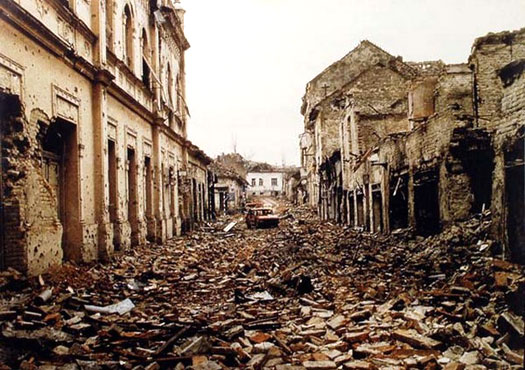 One of the first casualties of war in the Balkans was the infrastructure of areas of southern and south-eastern Croatia which were occupied by Serbian-dominated militia groups and rebels, with Vukovar being especially heavily bombed One of the first casualties of war in the Balkans was the infrastructure of areas of southern and south-eastern Croatia which were occupied by Serbian-dominated militia groups and rebels, with Vukovar being especially heavily bombed |
|
| The president of Serbia (rather than Yugoslavia), Slobodan Milošević, has been defeated at the first throw of the dice. However, Croatia will not be abandoned so lightly, triggering the Croatian War of Independence, or Croatian War. An initial attempt is made by Serb-dominated forces to sweep across Croatia to occupy it entirely. This fails when Croatian defence proves to be quite capable and stubborn. Even so, by the end of the year Croatia has lost approximately one third of its entire territory, with ethnic Croats in the occupied zone being subjected to a reign of terror. Much of the occupied zone is quickly reorganised into the self-proclaimed republic of Serbian Krajina. |
|
|
| 1992 |
Bosnia and Herzegovina holds its own referendum on departure. It is largely boycotted by the region's Serb population, but the remainder show enthusiastic support. Independence is officially announced on 3 March 1992. The rotating presidency of Yugoslavia is abandoned in June 1992. Thanks to forward planning by Yugoslavia, the Bosnian War soon consumes the region, as ethnic nationalists within Bosnia and Herzegovina, with the support of Serbia (mainly) and Croatia (to a limited extent) in some cases, attempt to take control of territories they claim as their own. Horrific ethnic cleansing campaigns between 1992 and the end of 1995 kill thousands and violently displace more than two million people across much of Bosnia and Herzegovina. 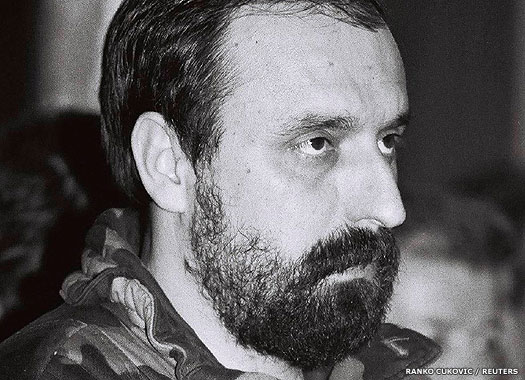 Goran Hadžić is seen here in 1993, during his time as leader of Serbian Krajina, but having fled during the territory's fall in 1995 he was arrested in 2011 and tried for war crimes Goran Hadžić is seen here in 1993, during his time as leader of Serbian Krajina, but having fled during the territory's fall in 1995 he was arrested in 2011 and tried for war crimes |
|
| 1993 - 1995 |
The situation in Serbian Krajina gradually declines, with newly-rearmed and retrained Croatia inflicting a notable territorial loss on it at the start of 1993 around Maslenica, and another in September when the Medak pocket in southern Krajina falls. By 1994 the Krajina has ninety-two percent unemployment, little operable industry, and subsistence-level agriculture. Its existence is terminated in August 1995 when Croatian forces quickly overrun the remainder of the territory. In 1995 international intervention into the Bosnian conflict leads finally to a peace agreement, the Dayton Accords, in late 1995. This, however, is not before the UN safe zone of Srebrenica is breached by Bosnian Serb forces and more than seven thousand Bosniak men and boys are massacred while UN ground forces are refused clearance to attempt to save them. |
|
| 1998 - 1999 |
The Kosovo War is triggered due to intensive Serbianisation of ethnic Albanian territory within the federal republic of Yugoslavia. The Kosovo Liberation Army (KLA) had been formed in the early 1990s to oppose Serbia's increasingly violent repression with its own militarised forces, albeit against the wishes of the president of the Kosovo region. Much of the weaponry being used by the Kosovan Albanians has come from state Albanian weapons stores, looted during its 1997 troubles. 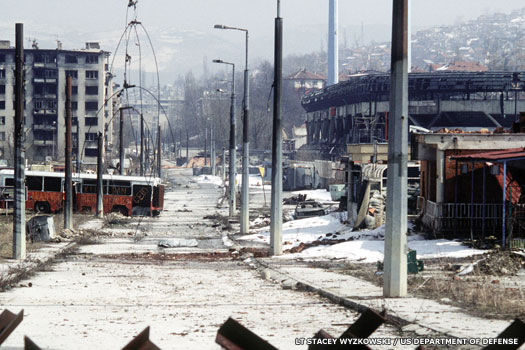 Grbavica, a suburb of Sarajevo, showed the full distress of the Bosnian War by 1995 when a ceasefire could finally be arranged between the two bitterly hostile sides Grbavica, a suburb of Sarajevo, showed the full distress of the Bosnian War by 1995 when a ceasefire could finally be arranged between the two bitterly hostile sides |
|
| With casualty numbers increasing rapidly and thousands of Kosovans pouring into FYROM and Albania, Nato intervenes, using its air superiority to push back Serbian troops. The war ends in the Kumanovo Treaty which sees Yugoslav Serb forces withdraw and a Nato peace-keeping force being assembled to police and protect the Kosovan autonomous region. |
|
|
| 2000 - 2003 |
Vojislav Koštunica |
President of Serbia & Yugoslavia. |
| 2003 |
To all intents and purposes, the Yugoslav state is terminated when the 'Union of Serbia and Montenegro' replaces it as an acceptance that Serbia has certainly lost its former dominance over the other constituent parts of the kingdom. |
|
| 2003 - 2006 |
Svetozar Marović |
Last president of Serbia & Montenegro. |
| 2006 |
The EU-brokered deal which forms the 'Union of Serbia and Montenegro' is intended to stabilise the region by settling Montenegrin demands for independence from Serbia and also to prevent further changes to Balkan borders. The same deal also contains the seeds of the union's dissolution. It stipulates that after three years (from 2003) the two republics can hold referenda on whether to keep or scrap it. It is scrapped, and a new Serbia emerges. |
|
|
|
|
Modern Serbia AD 2006 - Present Day Incorporating Heads of State (2006-2022) The modern Serbian state sits at the western centre of the Balkans. Officially known as the republic of Serbia, it is bordered by Romania to the north-east, Bulgaria to the south-east, North Macedonia to the south, Montenegro to the south-west, Bosnia and Herzegovina to the west, Croatia to the north-west, and Hungary to the north. The now-independent state, and former region, of Kosovo sits at its south-western corner, bordering Albania, having seceded in 2008. The capital, Belgrade (Beograd), is located at the northern centre of the country. Serbia's history essentially begins in the fifth and sixth centuries AD, when Slavs migrated gradually into the Balkans to take possession of territory between the Bulgars and the Adriatic. They were in part drawn southwards by the Eastern Roman empire which was eager to stem the advance of the Avars. Some Serb elements did remain in the north-eastern regions of Europe (known as White Serbs), including western Poland, eastern Germany and Saxony. They can still be found in Lausitz in Germany, and are now known as the Laustiz Serbs. The Balkans Serbs were able to form their own kingdom of [Serbia](#Kingdom of Serbia) in 1217. This quickly expanded into a regional empire before being subjugated by the Ottoman Turks in 1459. The beginnings of restored independence saw the creation of a principality at the start of the nineteenth century, which led to the restoration of the kingdom of Serbia in 1882. The collapse of [ Austria-Hungary](GermanyAustria.htm#Habsburg Emperors) in 1918 saw the Serbian kingdom rearranged into the 'Kingdom of Serbs, Croats & Slovenes', and then Yugoslavia in 1928. The Nazi German and Italian occupation of 1941 brought the kingdom to an end, but it was replaced by a federal, Socialist Yugoslavia which persisted until the break-up of the Soviet Union generated a similar break-up of the constituent Balkan states, some of which had never wanted to be in a Belgrade-dominated super-state anyway. The Balkans wars of the first half of the 1990s were brutal and merciless. From Belgrade, the fragmenting Yugoslavia attempted to hold onto its territories, partially by creating Serb-dominated enclaves which then fell, one-by-one. To all intents and purposes, the former Yugoslav state had been terminated when the 'Union of Serbia and Montenegro' replaced it in 2003 as an acceptance that Serbia had certainly lost its former dominance over the other constituent parts of the state. The EU-brokered deal behind this updated union was intended to stabilise the region by settling Montenegrin demands for full independence and also to prevent further changes to Balkan borders. The same deal also contained the seeds of the union's dissolution when the stipulated referenda on a full split could be held - in 2006. Montenegro decided to go its own way.  Since then, having also effectively lost Kosovo in 2008 when its people voted for full detachment from Belgrade, twenty-first century Serbia is gradually putting behind it the tragedy of its recent past to rebuild as a singular, independent country in a dramatically different Balkans. The Montenegrin 'divorce' of 2006 and the opportunity of a fresh start for Serbia gave rise to some speculation that the monarchy may be restored. Crown Prince Alexander had already moved back from exile in the UK in 2001 (see feature link). He supports a constitutional monarchy, but has made no overt attempt to establish one. Successive claimants to the Serbian throne are shown below with a shaded background. In its twenty-first century educational system, Serbia's children in their first grade of school learn the Cyrillic alphabet. In the second grade they learn the Latin alphabet. After that they spend afternoons handling two hours of Cyrillic work and two of Latin. The result is a bilingual society with bilingual street signs around Belgrade and a large number of younger people who can speak fluent English. Since then, having also effectively lost Kosovo in 2008 when its people voted for full detachment from Belgrade, twenty-first century Serbia is gradually putting behind it the tragedy of its recent past to rebuild as a singular, independent country in a dramatically different Balkans. The Montenegrin 'divorce' of 2006 and the opportunity of a fresh start for Serbia gave rise to some speculation that the monarchy may be restored. Crown Prince Alexander had already moved back from exile in the UK in 2001 (see feature link). He supports a constitutional monarchy, but has made no overt attempt to establish one. Successive claimants to the Serbian throne are shown below with a shaded background. In its twenty-first century educational system, Serbia's children in their first grade of school learn the Cyrillic alphabet. In the second grade they learn the Latin alphabet. After that they spend afternoons handling two hours of Cyrillic work and two of Latin. The result is a bilingual society with bilingual street signs around Belgrade and a large number of younger people who can speak fluent English.  Please note that the History Files does not regularly monitor changes in modern heads of state or their representatives. Get in touch here if this section requires updating. Please note that the History Files does not regularly monitor changes in modern heads of state or their representatives. Get in touch here if this section requires updating. |
|
|
 |
|
|
| (Information by Peter Kessler, with additional information by John De Cleene and from the John De Cleene Archive, from The Establishment of the Balkan National States, 1804-1920, Charles Jelavich & Barbara Jelavich (A History of East Central Europe, University of Washington Press, 1986), from The Collapse of Yugoslavia, 1991-1999, Alastair Finlan (Osprey Publishing, 2004), from The Death of Yugoslavia, Laura Silber & Allan Little (Penguin Books, 1996), and from External Links: Yugoslavia: death of a federation (The Guardian), and Nation-Building in Croatia and the Treatment of Minorities: Rights and Wrongs, Antonija Petricusic (L'Europe en Formation, 2008/3-4, No 349-350, available via Cairn.info), and Encyclopaedia Britannica, and Serbia defies EU deadline (The Guardian), and Kosovo fails in Unesco membership bid (The Guardian), and Serbia 'sliding towards autocracy' (The Guardian), and Serbian police fire teargas (The Guardian).) |
|
|
| 2006 - 2012 |
Boris Tadić |
President of Serbia (alone) since 2004. Resigned. |
| 2006 - Present |
Crown Prince Alexander II |
Claimant since 1970. In Belgrade from 2001. |
| 2006 |
Serbia loses Montenegro following a vote by the populace of the latter for full independence, completing the break-up of the Yugoslav state. In the lead up to the vote on independence, there had been fears of unrest in areas of Montenegro in which ethnic Serbs, who make up roughly a third of the country's population, had formed a majority opposition to separation from Serbia. Most ethnic Montenegrins and ethnic Albanians living in Montenegro had supported the move. In the event, no such unrest takes place. 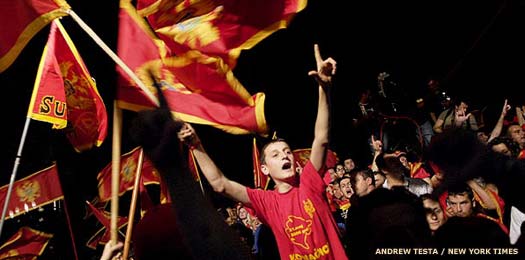 Unlike much of the separation of the Balkan states from Serbia, Montenegro's course towards independence was free of violence Unlike much of the separation of the Balkan states from Serbia, Montenegro's course towards independence was free of violence |
|
| 2008 |
Multilateral talks to determine Kosovo's future status have failed to yield a solution which is acceptable both to Serbs and Kosovars. Despite Serbia's opposition, Kosovo formally secedes from the country in February 2008. |
|
| 2012 |
Slavica Đukić Dejanović |
Female acting president (5 May-31 Apr). |
| 2012 - 2017 |
Tomislav Nikolić |
President of Serbia. Serbian Progressive Party (SNS). |
| 2013 |
After months of negotiation and several stumbling blocks, Kosovo and Serbia reach a landmark agreement on normalising relations which grants a high degree of autonomy to Serb-majority areas in northern areas, while both sides agree not to block each other's efforts to seek EU membership. |
|
| 2015 |
Kosovo fails in its bid to join Unesco, falling three votes short of the required two-thirds majority amongst member states. Unesco's executive board had recommended acceptance, despite Kosovo not being a UN member state. Serbia, which considers Kosovo to be the cradle of its identity and religion, strongly opposes the move throughout. 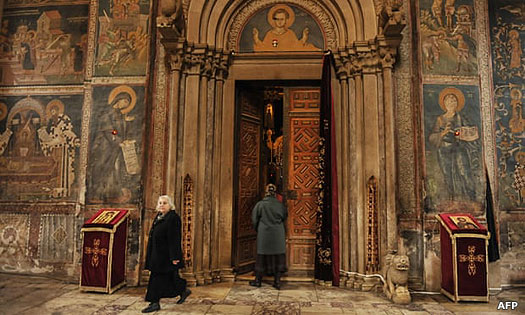 Unesco membership would have made Pristina custodian of Serbian Orthodox sites such as Decani Monastery, against which idea Belgrade strongly objects Unesco membership would have made Pristina custodian of Serbian Orthodox sites such as Decani Monastery, against which idea Belgrade strongly objects |
|
| 2017 - On |
Aleksandar Vučić |
President of Serbia. Serbian Progressive Party (SNS). |
| 2018 - 2020 |
Despite only being elected to office in 2017, President Aleksandar Vučić and his governing Serbian Progressive Party (SNS) have already ably demonstrated their intention to be anything but progressive. They oversee an increase in repression, and a degradation of press freedom and civil liberties. Mass protests break out in 2018 and continue into 2020, only to be suspended with the onset of the Covid-19 pandemic. June 2020 elections are largely boycotted by anyone other than diehard SNS supporters. |
|
| 2022 |
Democracy watchdogs and civil society activists in Serbia warn that the country is sliding towards autocracy under President Aleksandar Vučić, after he is re-elected for a second term in April with a large majority. Following a campaign which is marred by reports of widespread bribery, intimidation, and gerrymandering, Vučić wins sixty percent of the presidential vote, despite having shown strong sympathies in favour of Russia's aggressive stance in its invasion of Ukraine. 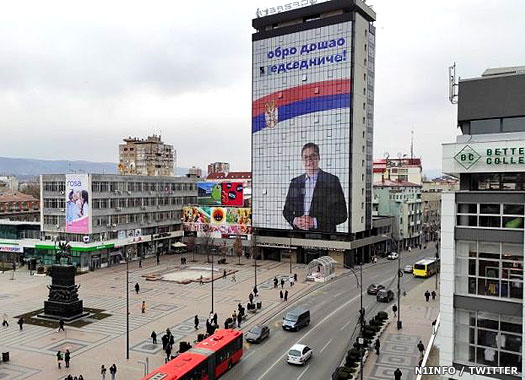 Following Russia's invasion of Ukraine, Serbian President Aleksandar Vučić attempted to balance between west and east, prompting many in Brussels and the EU to warn that he would have to get off the fence soon Following Russia's invasion of Ukraine, Serbian President Aleksandar Vučić attempted to balance between west and east, prompting many in Brussels and the EU to warn that he would have to get off the fence soon |
|
| 2023 |
According to state election commission preliminary results, in snap parliamentary elections on Sunday 17 December the populist ruling Serbian Progressive party (SNS) wins almost forty-seven percent of the votes. An international monitoring mission on the following Monday states that the SNS had gained an unfair advantage through media bias, the improper influence of President Aleksandar Vučić, and voting irregularities such as vote buying. Thousands gather in Belgrade to demand an annulment. |
|
| Crown Prince Peter |
Son and heir. Born 1980 Chicago. |
|
 |
|
|

 This artist's reconstruction shows the Roman city of Singidunum, the name originating in the preceding Celtic town, while the Serbs would settle it from the 520s, making it their on-off capital of Belgrade
This artist's reconstruction shows the Roman city of Singidunum, the name originating in the preceding Celtic town, while the Serbs would settle it from the 520s, making it their on-off capital of Belgrade The (First) Bulgarian empire had controlled a great swathe of the Balkans during its existence, but its termination in 971 resulted in only its western territories remaining independent (within the dashed line), governed by the cometopuli (click or tap on map to view full sized)
The (First) Bulgarian empire had controlled a great swathe of the Balkans during its existence, but its termination in 971 resulted in only its western territories remaining independent (within the dashed line), governed by the cometopuli (click or tap on map to view full sized)


 Josip Broz Tito, president and marshal of the federal republic of Yugoslavia in 1947, dressed to celebrate the second anniversary of the defeat of Nazi Germany
Josip Broz Tito, president and marshal of the federal republic of Yugoslavia in 1947, dressed to celebrate the second anniversary of the defeat of Nazi Germany Enver Hoxha, here photographed alongside his wife, Nexhmije Hoxha, pursued a ruthless purge of intellectuals of the like which was often seen during the brutal pro-communist years of the post-Second World War period
Enver Hoxha, here photographed alongside his wife, Nexhmije Hoxha, pursued a ruthless purge of intellectuals of the like which was often seen during the brutal pro-communist years of the post-Second World War period Tito was honoured with a state funeral following his death in 1980: viewed by many as the father and saviour of the Yugoslav state, his loss meant the beginning of great changes in the Balkans
Tito was honoured with a state funeral following his death in 1980: viewed by many as the father and saviour of the Yugoslav state, his loss meant the beginning of great changes in the Balkans Slobodan Milošević was photographed here just after he had signed the Dayton Accords (or Dayton Agreement), the 1995 peace agreement which arranged the post-war political landscape in the Balkans
Slobodan Milošević was photographed here just after he had signed the Dayton Accords (or Dayton Agreement), the 1995 peace agreement which arranged the post-war political landscape in the Balkans One of the first casualties of war in the Balkans was the infrastructure of areas of southern and south-eastern Croatia which were occupied by Serbian-dominated militia groups and rebels, with Vukovar being especially heavily bombed
One of the first casualties of war in the Balkans was the infrastructure of areas of southern and south-eastern Croatia which were occupied by Serbian-dominated militia groups and rebels, with Vukovar being especially heavily bombed Goran Hadžić is seen here in 1993, during his time as leader of Serbian Krajina, but having fled during the territory's fall in 1995 he was arrested in 2011 and tried for war crimes
Goran Hadžić is seen here in 1993, during his time as leader of Serbian Krajina, but having fled during the territory's fall in 1995 he was arrested in 2011 and tried for war crimes Grbavica, a suburb of Sarajevo, showed the full distress of the Bosnian War by 1995 when a ceasefire could finally be arranged between the two bitterly hostile sides
Grbavica, a suburb of Sarajevo, showed the full distress of the Bosnian War by 1995 when a ceasefire could finally be arranged between the two bitterly hostile sides Since then, having also effectively lost Kosovo in 2008 when its people voted for full detachment from Belgrade, twenty-first century Serbia is gradually putting behind it the tragedy of its recent past to rebuild as a singular, independent country in a dramatically different Balkans. The Montenegrin 'divorce' of 2006 and the opportunity of a fresh start for Serbia gave rise to some speculation that the monarchy may be restored. Crown Prince Alexander had already moved back from exile in the UK in 2001 (see feature link). He supports a constitutional monarchy, but has made no overt attempt to establish one. Successive claimants to the Serbian throne are shown below with a shaded background. In its twenty-first century educational system, Serbia's children in their first grade of school learn the Cyrillic alphabet. In the second grade they learn the Latin alphabet. After that they spend afternoons handling two hours of Cyrillic work and two of Latin. The result is a bilingual society with bilingual street signs around Belgrade and a large number of younger people who can speak fluent English.
Since then, having also effectively lost Kosovo in 2008 when its people voted for full detachment from Belgrade, twenty-first century Serbia is gradually putting behind it the tragedy of its recent past to rebuild as a singular, independent country in a dramatically different Balkans. The Montenegrin 'divorce' of 2006 and the opportunity of a fresh start for Serbia gave rise to some speculation that the monarchy may be restored. Crown Prince Alexander had already moved back from exile in the UK in 2001 (see feature link). He supports a constitutional monarchy, but has made no overt attempt to establish one. Successive claimants to the Serbian throne are shown below with a shaded background. In its twenty-first century educational system, Serbia's children in their first grade of school learn the Cyrillic alphabet. In the second grade they learn the Latin alphabet. After that they spend afternoons handling two hours of Cyrillic work and two of Latin. The result is a bilingual society with bilingual street signs around Belgrade and a large number of younger people who can speak fluent English.  Please note that the History Files does not regularly monitor changes in modern heads of state or their representatives. Get in touch here if this section requires updating.
Please note that the History Files does not regularly monitor changes in modern heads of state or their representatives. Get in touch here if this section requires updating.
 Unlike much of the separation of the Balkan states from Serbia, Montenegro's course towards independence was free of violence
Unlike much of the separation of the Balkan states from Serbia, Montenegro's course towards independence was free of violence Unesco membership would have made Pristina custodian of Serbian Orthodox sites such as Decani Monastery, against which idea Belgrade strongly objects
Unesco membership would have made Pristina custodian of Serbian Orthodox sites such as Decani Monastery, against which idea Belgrade strongly objects Following Russia's invasion of Ukraine, Serbian President Aleksandar Vučić attempted to balance between west and east, prompting many in Brussels and the EU to warn that he would have to get off the fence soon
Following Russia's invasion of Ukraine, Serbian President Aleksandar Vučić attempted to balance between west and east, prompting many in Brussels and the EU to warn that he would have to get off the fence soon